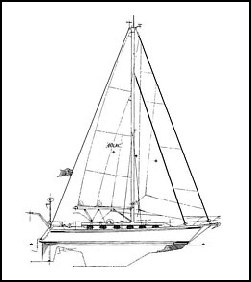
and poking
into every corner of my boat for the last three years, I…have found no
area where Caliber has compromised on the strength and structural
integrity of the boat. I don’t believe there is a more strongly built
boat on the market today." So it is no surprise that scores in
construction categories average between 8 and 10. Average rating of
overall hull construction is just under 9, with several perfect 10s,
probably coincidentally for boats built in 1995. With heavy 24-oz. Woven
roving and mat, Caliber creates thick hull laminates that are stiffer
and have higher breaking strengths.
Caliber has married
marketing education and effectively pitched a number of titled
construction and design systems that cover the important seamanlike
bases and help consumers make informed buying decisions. Thus, holing of
the hulls is minimized by what Caliber calls, "Reinforced Impact Zones"
at the bow in the area of the waterline and at the forward edge of the
long modified fin keel. These are extra layers of solid fiberglass
applied to those spots most likely to be damaged by striking floating
and semi-submerged objects while under way. There’s nothing
Similarly, Caliber’s "Integral Strength-Grid System" probably accounts for high scores for "stringers & floors" (average score of 9). With this grid system, keel, tanks, lids, baffles, stringers and subsole are heavily glassed together to form a powerful grid structure that is integral to and the backbone of the hull and as the builder says, "spreads primary sea loads over a large area." Early variations of this idea were employed by both Ericson and Hunter in the early ‘80s. First designed by David Pedrick, and dubbed the "Triaxial Grid System" by Ericson, it really works. LRC owners know of this method’s efficiency, and are justifiably impressed.
Unabashed enthusiasm for "bulkheads & braces" (average score of 9.3) are due in part to Caliber’s "Multi-Bulkhead Bonding System." With this, all horizontal and vertical surfaces--e.g., bulkheads, frames and shelves--are completely hand-laminated to the hull with fiberglass tape, further strengthening and stiffening the hull and eliminating non-structural liners. This practice of incorporating the furniture as a structural component of the hull is also known as monocoque construction
Caliber 40LRC
LOA 40’ 11”
LWL 32’ 6”
Beam 12’8”
Draft 5’ 1”
Displacement 21,600 lbs.
Ballast 9,500 lbs.
Sail Area 739 Sq. Ft.
Disp/Length 281
Sail/Disp 15.25
Ballast/Disp 44%
Water 179 gal Fuel 212 gal Est. Range 1,484nm